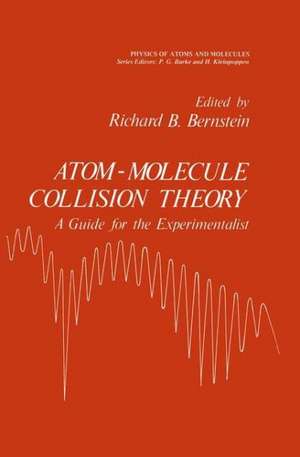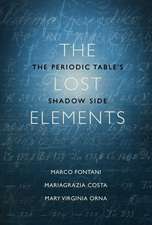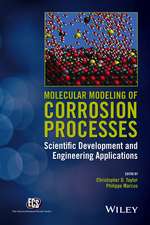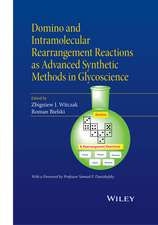Atom - Molecule Collision Theory: A Guide for the Experimentalist: International Studies in Economic Modelling
Editat de Richard Barry Bernsteinen Limba Engleză Paperback – 16 apr 2013
Preț: 968.19 lei
Preț vechi: 1180.73 lei
-18% Nou
Puncte Express: 1452
Preț estimativ în valută:
185.27€ • 194.82$ • 153.08£
185.27€ • 194.82$ • 153.08£
Carte tipărită la comandă
Livrare economică 17 aprilie-01 mai
Preluare comenzi: 021 569.72.76
Specificații
ISBN-13: 9781461329152
ISBN-10: 1461329159
Pagini: 800
Ilustrații: XX, 779 p. 27 illus.
Dimensiuni: 155 x 235 x 42 mm
Greutate: 1.1 kg
Ediția:Softcover reprint of the original 1st ed. 1979
Editura: Springer Us
Colecția Springer
Seria International Studies in Economic Modelling
Locul publicării:New York, NY, United States
ISBN-10: 1461329159
Pagini: 800
Ilustrații: XX, 779 p. 27 illus.
Dimensiuni: 155 x 235 x 42 mm
Greutate: 1.1 kg
Ediția:Softcover reprint of the original 1st ed. 1979
Editura: Springer Us
Colecția Springer
Seria International Studies in Economic Modelling
Locul publicării:New York, NY, United States
Public țintă
ResearchCuprins
Chap. 1. Introduction to Atom—Molecule Collisions : The Interdependency of Theory and Experiment.- 1. General Introduction.- 2. The Experimentalist’s “Need to Know”.- 3. Overview of Experiments in Atom—Molecule Collisions.- 3.1. Elastic Scattering.- 3.2. Inelastic Scattering.- 3.3. Electronic Excitation and Curve Crossing.- 3.4. Reactive Scattering.- 4. Experimental Examples.- 4.1. Elastic Scattering.- 4.2. Rotationally Inelastic Scattering.- 4.3. Vibrationally Inelastic Scattering.- 4.4. Electronic Excitation and Charge Transfer.- 4.5. Reactive Atom—Molecule Scattering.- 4.6. Collision-Induced Dissociation.- 5. Information Content of Atom—Molecule Molecule Collision Cross Sections.- 6. Future Theoretical Demands of the Experimentalist.- References.- Chap. 2. Interaction Potentials I : Atom—Molecule Molecule Potentials.- 1. Current State of Ab Initio Electronic Structure Theory.- 2. Philosophy : Judicious Synthesis of Theory and Experiment.- 3. Brief Survey of Methods.- 3.1. Basis Sets.- 3.2. The Problem of Electron Correlation.- 3.2.1. The Concept.- 3.2.2. Configuration Interaction (CI).- 4. Examples.- 4.1. Nonreactive.- 4.1.1. Li+—H2.- 4.1.2. He—H2CO.- 4.2. Reactive.- 4.2.1. H + H2.- 4.2.2. Fluorine—Hydrogen Systems.- 4.2.3. N+ + H2.- 4.2.4. H + Li2, F + Li2.- 4.2.5. H + C1H, H + BrH.- 5. Concluding Remarks.- References.- Chap. 3. Interaction Potentials II: Semiempirical Atom—Molecule Potentials for Collision Theory.- 1. Introduction.- 1.1. Potential Surfaces for Collision Theory.- 1.2. Requisites for the Potential Energy Surface and Its Representation.- 1.2.1. Physical Requirements.- 1.2.2. Computational Requirements.- 1.3. Selection of Methods.- 2. The Method of Diatomics-in-Molecules (DIM).- 2.1. Introduction.- 2.2. General Formulation.-2.2.1. Defining the Scope of the Problem.- 2.2.2. The DIM Basis Set.- 2.2.3. The DIM Hamiltonian Matrix.- 2.2.4. The DIM Eigenvalues.- 2.3. A Specific Example: FH2.- 2.3.1. Define the Coordinate System.- 2.3.2. Define the Atomic Basis Functions and Fragment Matrices.- 2.3.3. Define the Diatomic Basis and Fragment Matrices.- 2.3.4. Compute the Rotated Fragment Matrices.- 2.3.5. Construct the Triatomic Basis.- 2.3.6. Construct the Atomic Matrices B.- 2.3.7. Construct the Diatomic Matrices B.- 2.3.8. Find the DIM Eigenvalues.- 2.4. Simple Systems: An Alternative Formulation.- 2.5. Coupling.- 2.5.1. Spin—Orbit Coupling.- 2.5.2. Nonadiabatic Coupling.- 3. Methods Related to DIM.- 3.1. The LEPS Method.- 3.2. Method of Blais and Truhlar.- 3.3. Valence-Bond Methods.- 3.3.1. Porter—Karplus Surface for H3.- 3.3.2. Valence-Bond Methods with Transferable Parameters.- 3.4. Simple Approach to Nonadiabatic Coupling.- References.- Chap. 4. Elastic Scattering Cross Sections I: Spherical Potentials.- 1. Introduction.- 2. Intermolecular Potential.- 2.1. The Concept of an Intermolecular Potential.- 2.2. General Behavior of the Intermolecular Potential.- 2.3. Potential Models Used in the Evaluation of Scattering Cross Sections.- 2.3.1. Basic Potential Models.- 2.3.2. Modifications of the Basic Potentials and Piecewise Analytic Potentials.- 2.3.3. The Simons—Parr—Finlan (SPF) Modified Dunham Expansion.- 3. Definitions of the Quantities That Can Be Measured in Elastic-Scattering Experiments. Influence of Experimental Conditions.- 4. Classical Scattering Theory.- 4.1. Basic Formulas.- 4.2. Differential Cross Section.- 4.2.1. Small-Angle Scattering.- 4.2.2. Glory Scattering.- 4.2.3. Rainbow Scattering.- 4.2.4. Large-Angle Scattering.- 4.2.5. Orbiting Collisions.- 4.2.6. Summary of theClassical Results for the Differential Scattering Cross Section and Limits of Validity.- 4.3. Total Elastic Cross Sections.- 4.4. Identical Particles.- 4.5. First-Order Momentum Approximation and Results for the Basic Potentials.- 5. Quantal Treatment.- 5.1. Introduction.- 5.2. Stationary Scattering Theory and Partial-Wave Analysis.- 5.3. Examples of Numerical Results.- 5.3.1. Differential Cross Sections.- 5.3.2. Total Scattering Cross Section.- 5.4. Resonance Scattering.- 5.5. Identical Particles.- 6. Semiclassical Approximation.- 6.1. General Assumptions and Introductory Remarks.- 6.2. Special Features of the Differential Cross Section.- 6.2.1. Interference Effects.- 6.2.2. Rainbow Scattering.- 6.2.3. Orbiting Collisions.- 6.2.4. Large-Angle Scattering.- 6.2.5. Glory Scattering.- 6.2.6. Small-Angle Scattering (Forward Diffraction Peak).- 6.3. Special Features of the Total Elastic Scattering Cross Section.- 6.4. Identical Particles.- 6.5. High-Energy Approximation.- 6.5.1. Brief Outline of the Method.- 6.5.2. Results for the Basic-Potential Models.- 7. Methods for the Evaluation of Potentials from Experimental Scattering Data.- 7.1. General Survey.- 7.2. Semiclassical Inversion Procedures.- 7.2.1. Determination of the Repulsive Part of the Potential from the s-Phase as a Function of the Energy.- 7.2.2. Determination of the Potential from the Phase Shift Function or the Deflection Function at a Fixed Energy.- 7.2.3. Determination of the Phase Shift Function ?(?) or the Classical Deflection Function ?(?) from an Analysis of Differential Cross Section Data.- 7.2.4. The Inverse Problem in the High-Energy Approximation.- 7.3. The Trial and Error Method and Regression Procedures.- 7.4. The Use of Pseudopotentials.- References.- Chap. 5. Elastic Scattering Cross SectionsII: Noncentral Potentials.- 1. Introduction.- 2. Angular-Dependent Potentials.- 2.1. The General Form.- 2.2. The Long-Range Terms.- 2.3. Eccentricity Effects.- 2.4. Action Integrals.- 3. General Expressions and Close-Coupling Calculations.- 4. The Distorted-Wave Approximation.- 5. Sudden Approximation.- 6. The Calculation of Cross Sections in Sudden Approximation.- 6.1. The Differential Cross Section in Sudden Approximation.- 6.2. The Integral Cross Section in Sudden Approximation: The Nonglory Contribution.- 6.3. The Total Integral Cross Section in Sudden Approximation: The Glory Contribution.- 7. Conclusions.- Glossary of Abbreviations.- References.- Chap. 6. Inelastic Scattering Cross Sections I: Theory.- 1. Introduction.- 2. Observables and Averaging.- 3. Quantum Theory of Inelastic Scattering.- 3.1. Formal Quantum Theory.- 3.2. Angular Momentum Conservation, Parity, and Close-Coupled Equations.- 3.3. Asymptotic Forms and the S Matrix.- 3.4. Symmetry and Microscopic Reversibility.- 3.5. Integral Equations and Square Integrable Techniques.- 4. Approximate Approaches.- 4.1. Dimension-Reducing Approximations (DRA’s).- 4.2. Perturbation Theory.- 4.3. Chemical Dynamics.- References.- Chap. 7. Inelastic Scattering Cross Sections II: Approximation Methods.- 1. Introduction.- 2. Rotational Excitation.- 3. Vibrational Excitation.- 4. Electronic Excitation.- References.- Chap. 8. Rotational Excitation I: The Quantal Treatment.- 1. Introduction.- 2. The Coupled Equations for Rotational Scattering.- 3. Solution of the Close-Coupling Equations.- 4. Methods of Solution of the Coupled Scattering Equations.- 4.1. The Approximate-Solution Approach in the Solution-Following Technique: The Method of Sams and Kouri.- 4.2. The Approximate-Potential Approach in the Solution-FollowingTechnique.- 4.3. The Approximate-Potential Approach in the Invariant-Imbedding: Technique: The R-Matrix Method.- 4.4. The Approximate-Solution Approach in the Invariant-Imbedding Technique: The Log-Derivative Method.- References.- Chap. 9. Rotational Excitation II: Approximation Methods.- 1. Introduction.- 2. The CS Approximation.- 2.1. The Basic CS Equations.- 2.2. The CS Scattering Amplitude and Boundary Conditions.- 2.3. CS Differential and Integral Cross Sections.- 2.4. CS Approximation for General Relaxation Cross Sections.- 3. The IOS Approximation.- 3.1. Basic IOS Equations and Boundary Conditions.- 3.2. IOS Cross Sections and Factorizations.- 3.3. IOS Factored Rates and Transport Properties.- 4. The lz-Conserving Energy Sudden Approximation.- 4.1. Basic lz-Conserving Equations and Boundary Conditions.- 4.2. Factorization of lz-Conserving Amplitudes and Cross Sections.- 5. The Decoupled l-Dominant Approximation.- 6. Exponential Distorted-Wave Approximation.- 7. Semiclassical Approximation.- 8. Method Selection.- 8.1. Energy Sudden Approximation.- 8.2. Centrifugal Sudden Approximation.- 8.3. Infinite-Order Sudden Approximation.- 8.4. lz-Conserving and DLD Approximations.- 8.5. Exponential Distorted-Wave Approximation.- 8.6. Semiclassical Approximations.- 8.7. Full Close Coupling.- References.- Chap. 10. Rotational Excitation III: Classical Trajectory Methods.- 1. Introduction.- 2. Ingredients of a Trajectory Calculation.- 2.1. Equations of Motion.- 2.2. Selection of Initial Conditions.- 2.3. Integration of Equations of Motion.- 2.4. Analysis of Final Conditions.- 3. Construction of a Trajectory Program.- 4. Efficiency-Improving Techniques.- 4.1. Alternative Sampling Schemes.- 4.2. Moment Methods.- 5. Concluding Remarks.- References.- Chap. 11. Vibrational Excitation I: The Quantal Treatment.- 1. Introduction.- 2. Angular Momentum Decoupling Approximations.- 3. Asymptotic Expansion Technique for Handling Long-Range Potentials.- 4. Effects of the Dissociative Continuum.- References.- Chap. 12. Vibrational Excitation II: Classical and Semiclassical Methods.- 1. Introduction.- 2. Quasiclassical Methods.- 3. Semiclassical Methods.- 3.1. Quantal Internal Modes Coupled through the Interaction Potential to Classical Translational Motion.- 3.2. Classical S-Matrix Theory.- 3.3. Classical—Quantal Correspondence Methods.- 3.3.1. The decent and indecent Methods.- 3.3.2. The Strong-Coupling Correspondence Principle.- 3.4. Models for Special Cases.- 3.4.1. itfits Models.- 3.4.2. Angular Dependence of Impulsive Energy Transfer.- 3.4.3. Near-Resonant V—V and V—R Transitions Induced by Long-Range Forces.- 4. Approximations.- 4.1. Dynamical Approximations.- 4.1.1. Sudden Approximation (SA).- 4.1.2. Impact Parameter (IP) Approximation.- 4.1.3. Neglect of ?T.- 4.2. Dimensional Approximations.- 4.2.1. Collinear Models.- 4.2.2. The Breathing Sphere (BS) Model.- 4.3. Influence of the Potential Energy Surface.- 4.3.1. Diatomic Molecule Potential.- 4.3.2. Interaction Potential.- 5. Conclusions and Recommendations.- References.- Chap. 13. Electronic Excitation: Nonadiabatic Transitions.- 1. Introduction.- 1.1. Physical Considerations.- 1.2. Notation.- 2. Equations of Motion.- 2.1. The Body-Fixed Hamiltonian.- 2.2. Adiabatic and Diabatic Representations.- 2.2.1. Diabatic Representation.- 2.2.2. Adiabatic Representation.- 2.2.3. Diabatic-to-Adiabatic Transformation.- 2.2.4. Two-State Model.- 2.2.5. Reduced Adiabatic and Diabatic Representations.- 2.2.6. Choice of Representation.- 2.3. Nonadiabatic Coupling Mechanisms.- 2.3.1. ConfigurationInteraction.- 2.3.2. Spin—Orbit Coupling.- 2.3.3. Angular Momentum Decoupling.- 3. Nonadiabatic Transition Probabilities and Cross Sections.- 3.1. Two-State Models in One Degree of Freedom.- 3.1.1. Curve Crossing.- 3.1.2. Demkov Coupling.- 3.2. Inelastic Atom—Atom Scattering.- 3.2.1. Differential Cross Section.- 3.2.2. Total Cross Section.- 3.3. Inelastic and Reactive Collinear Atom—Diatom Scattering.- 3.3.1. Vibronic Network Formulation.- 3.3.2. Multi-Curve-Crossing Approximations.- 3.3.3. Franck—Condon Approximation.- 3.3.4. Surface-Hopping Trajectory Approximations.- 3.3.5. Comparison and Conclusions.- References.- Chap. 14. Reactive Scattering Cross Sections I: General Quantal Theory.- 1. Introduction.- 2. Quantal Reactive Scattering Processes.- 3. Formal Scattering Theory for Reactive Collisions.- 4. R-Matrix Theory.- 5. Coupled-Equations Approach.- 6. Summary.- References.- Chap. 15. Reactive Scattering Cross Sections II: Approximate Quantal Treatments.- 1. Introduction.- 2. Angular Momentum Decoupling: J=, Conserving.- 3. Born-Type Approximations.- 3.1. T-Matrix Elements and Distortion Potentials.- 3.2. Born Approximation: Energy Dependence of the Total Reaction Cross Section.- 3.3. Born Approximation: Product State Internal Energy Distributions.- 3.4. Spectator-Stripping Model.- 3.5. Distorted Waves: Methodology.- 3.6. Distorted Waves: Numerical Results.- 4. Overlap Models (Franck—Condon Factors).- 4.1. Introduction.- 4.2. Collinear Reactions: Vibrational Distributions.- 4.3. Three-Dimensional Reactions: Vibration—Rotation Distributions.- 5. Other Approaches, and Conclusions.- References.- Chap. 16. Reactive Scattering Cross Sections III: Quasiclassical and Semiclassical Methods.- 1. Introduction.- 2. Quasiclassical Trajectory Method.- 2.1.Equations of Motion.- 2.2. Initial Conditions.- 2.3. Calculation of a Trajectory.- 2.4. Sampling and Averaging over the Initial Conditions.- 2.5. Product Analysis.- 2.6. Calculation of Reaction Attributes.- 2.6.1. Reactivity Functions.- 2.6.2. Final-State Distributions.- 2.6.3. Initial-State—Final-State Correlations.- 2.7. Available Programs.- 3. Other Trajectory Methods for Single-Surface Reactions.- 3.1. Unquantized Initial and Final Conditions.- 3.2. Symmetrically Averaged Initial and Final Conditions.- 3.3. Exactly Quantized Initial and Final Conditions.- 3.4. Classical S Matrix Theory and Other Semiclassical Methods That Include Interference Effects.- 4. Trajectory Methods for Multisurface Reactions.- 5. Concluding Remarks.- References.- Chap. 17. Direct-Mode Chemical Reactions I: Methodology for Accurate Quantal Calculations.- 1. Introduction.- 2. Coordinate Geometry and Hamiltonian.- 2.1. Space-Fixed and Body-Fixed Coordinates.- 2.2. Natural Translation—Vibration Coordinates.- 2.3. Natural Bending Angle.- 2.4. Matching Surfaces and Arrangement Tubes.- 3. Internal Basis Sets.- 3.1. Partitioning of Hamiltonian.- 3.2. Vibrational Basis.- 3.3. Rotational Bases.- 3.3.1. Free-Rotor and Adiabatic Representations.- 3.3.2. Asymmetric-Top Correlation Diagrams.- 3.3.3. Partitioned Rotors.- 4. Close-Coupling Equations.- 4.1. Wave Function Scaling and Basis Expansion.- 4.2. Propagation Equations.- 4.3. Integration Techniques.- 4.4. Numerical Details.- 5. Matching Surface Continuity and Asymptotic Boundary Conditions.- 6. Selected Results.- 6.1. Threshold Energies: H + H2.- 6.2. Resonance Effects: H + H2.- 6.3. Quantized Whirlpools:F + H2.- 7. Concluding Remarks.- References.- Chap. 18. Direct-Mode Chemical Reactions II: Classical Theories.- 1. Introduction.- 2.Determination of Relevant Potential Surfaces.- 3. Models for Multisurface Reactions.- 4. Simple Models for Single-Surface Reactions.- 4.1. Entrance-Channel Models.- 4.2. Channel-to-Channel Models and Angular Momentum Considerations.- 4.3. More Detailed Dynamic Models of Product-State Distributions.- 5. Numerical Trajectories.- 5.1. Angular Distributions.- 5.2. Rotational Energy.- 5.3. Vibrational Energy.- References.- Chap. 19. Complex-Mode Chemical Reactions: Statistical Theories of Bimolecular Reactions.- 1. Introduction.- 2. Averaging and Constraints.- 3. Statistical Theories.- 3.1. “Loose” Transition States.- 3.2. “Tight” Transition States.- References.- Chap. 20. Collision-Induced Dissociation I: Quantal Treatment.- 1. Introduction.- 2. Quantal Description of the CID Process.- 3. Quantal Approximation Methods.- 3.1. Born Approximation (BA).- 3.2. Distorted-Wave Born Approximation (DWBA).- 3.3. Variational Methods.- 3.4. Impulse Approximation (IA).- 4. Close-Coupling Methods.- 5. Concluding Remarks.- References.- Chap. 21. Collision-Induced Dissociation II: Trajectories and Models.- 1. Classical Trajectory Calculations.- 1.1. General Considerations.- 1.1.1. Introduction.- 1.1.2. Choosing a Potential Energy Surface.- 1.2. Identification of the Product Channel for CID.- 1.2.1. General Strategy.- 1.2.2. The Strong-Coupling Region (SCR).- 1.2.3. Quasibound Molecules.- 1.2.4. Identification of CID Channel.- 2. Classical Models for CID.- 2.1. Overview.- 2.1.1. Availability.- 2.1.2. Dynamical Models.- 2.1.3. Hard-Sphere Models.- 2.1.4. Recommendations.- 2.2. The Square-Well Trajectory Model.- 2.2.1. The Potential Energy Function.- 2.2.2. Quasibound Molecules.- 2.2.3. Method of Calculation.- 2.3. Statistical Approaches.- 3. Summary.- References.- Chap. 22.Information-Theoretic Approach: Application to Molecular Collisions.- 1. Introduction.- 1.1. Overview.- 1.1.1. Surprisal Analysis.- 1.1.2. Information Content.- 1.1.3. Constraints: Informative Observables.- 1.1.4. Inductive and Deductive Reasoning.- 1.1.5. Surprisal Synthesis via Inductive Reasoning.- 1.2. Example: Rotational Energy Transfer.- 1.3. The Prior Distribution.- 1.3.1. Counting Final States.- 1.3.2. Counting Translational States.- 1.3.3. Entropy and Entropy Deficiency.- 1.3.4. Theoretical Distributions.- 1.3.5. Transition State Theory.- 1.4. Example: Products’ Translational Energy Distribution.- 1.4.1. Counting Final States.- 1.4.2. The Prior Distribution.- 1.4.3. Translational Surprisal.- 1.5. Guideposts for Surprisal Analysis.- 1.5.1. Determine the Frequencies.- 1.5.2. Determine the Conditions.- 1.5.3. Find the Prior.- 1.5.4. Determine the Surprisal.- 1.5.5. Surprisal Analysis.- 1.5.6. Optional: Refinements.- 1.5.7. For Model Builders Only.- 1.5.8. Optional: Surprisal Synthesis.- 2. State-to-State Chemistry.- 2.1. The Probability Matrix.- 2.1.1. The Collision Theory Canon.- 2.1.2. The Reasonable Person’s P Matrix.- 2.1.3. The Distribution of Reactive Reactants.- 2.1.4. The Poor Person’s P Matrix.- 2.1.5. Constructing the P Matrix.- 2.2. Symmetry.- 2.2.1. Detailed Balance.- 2.2.2. The P Matrix at a Given Total Energy.- 2.2.3. The Reverse Reaction.- 2.2.4. The P Matrix at a Given Temperature.- 2.2.5. An Application of Detailed Balance.- 2.3. Prior and Deviant P Matrices.- 2.3.1. The Prior Distribution.- 2.3.2. Surprisal Analysis at a Given Total Energy.- 2.3.3. Surprisal Analysis at a Given Temperature.- 2.3.4. Summary: Surprisal Analysis.- 2.4. Examples.- 2.4.1. Reagent Energy Consumption.- 2.4.2. Rotational Energy Transfer.- 2.4.3. VibrationalEnergy.- 2.4.4. Temperature Dependence.- 2.4.5. Energy Dependence.- 2.4.6. Branching Ratios.- 2.5. Surprisal Synthesis for P Matrices.- 2.5.1. Rotational Distributions.- 2.5.2. Translational Distributions.- 2.5.3. Branching Ratios, Reactive Reactants, and Other Marginals.- 2.6. Mutual Distributions.- 2.7. Summary.- Appendix A. Handbook of Prior Distributions.- A.1. Density of States.- A.1.1. Atom—Diatom.- A.1.2. Diatom—Diatom.- A.2. Prior Distributions at a Given Total Energy.- A.3. Prior Distributions at a Given Temperature.- Appendix B. The Persuasion.- Appendix C. The Determination of the Lagrange Parameters.- References.- Author Index.


















